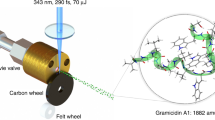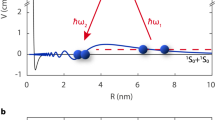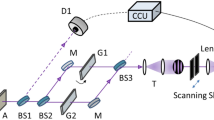Abstract
Matter-wave interference experiments provide a direct confirmation of the quantum superposition principle, a hallmark of quantum theory, and thereby constrain possible modifications to quantum mechanics1. By increasing the mass of the interfering particles and the macroscopicity of the superposition2, more stringent bounds can be placed on modified quantum theories such as objective collapse models3. Here, we report interference of a molecular library of functionalized oligoporphyrins4 with masses beyond 25,000 Da and consisting of up to 2,000 atoms, by far the heaviest objects shown to exhibit matter-wave interference to date. We demonstrate quantum superposition of these massive particles by measuring interference fringes in a new 2-m-long Talbot–Lau interferometer that permits access to a wide range of particle masses with a large variety of internal states. The molecules in our study have de Broglie wavelengths down to 53 fm, five orders of magnitude smaller than the diameter of the molecules themselves. Our results show excellent agreement with quantum theory and cannot be explained classically. The interference fringes reach more than 90% of the expected visibility and the resulting macroscopicity value of 14.1 represents an order of magnitude increase over previous experiments2.
This is a preview of subscription content, access via your institution
Access options
Access Nature and 54 other Nature Portfolio journals
Get Nature+, our best-value online-access subscription
$29.99 / 30 days
cancel any time
Subscribe to this journal
Receive 12 print issues and online access
$209.00 per year
only $17.42 per issue
Buy this article
- Purchase on Springer Link
- Instant access to full article PDF
Prices may be subject to local taxes which are calculated during checkout



Similar content being viewed by others
Data availability
The data that support the plots within this paper and other findings of this study are available from the corresponding author on request.
References
Arndt, M. & Hornberger, K. Testing the limits of quantum mechanical superpositions. Nat. Phys. 10, 271–277 (2014).
Nimmrichter, S. & Hornberger, K. Macroscopicity of mechanical quantum superposition states. Phys. Rev. Lett. 110, 160403 (2013).
Bassi, A., Lochan, K., Satin, S., Singh, T. P. & Ulbricht, H. Models of wave-function collapse, underlying theories, and experimental tests. Rev. Mod. Phys. 85, 471–527 (2013).
Sezer, U., Schmid, P., Felix, L., Mayor, M. & Arndt, M. Stability of high-mass molecular libraries: the role of the oligoporphyrin core. J. Mass Spectrom. 50, 235–239 (2015).
Friedman, J. R., Patel, V., Chen, W., Tolpygo, S. K. & Lukens, J. E. Quantum superposition of distinct macroscopic states. Nature 406, 43–46 (2000).
Andrews, M. R. et al. Observation of interference between two Bose condensates. Science 275, 637–641 (1997).
Marinković, I. et al. Optomechanical Bell test. Phys. Rev. Lett. 121, 220404 (2018).
Kovachy, T. et al. Quantum superposition at the half-metre scale. Nature 528, 530–533 (2015).
Eibenberger, S., Gerlich, S., Arndt, M., Mayor, M. & Tüxen, J. Matter-wave interference of particles selected from a molecular library with masses exceeding 10,000 amu. Phys. Chem. Chem. Phys. 15, 14696–14700 (2013).
Gerlich, S. et al. A Kapitza–Dirac–Talbot–Lau interferometer for highly polarizable molecules. Nat. Phys. 3, 711–715 (2007).
Nairz, O., Brezger, B., Arndt, M. & Zeilinger, A. Diffraction of complex molecules by structures made of light. Phys. Rev. Lett. 87, 160401 (2001).
Hornberger, K. et al. Theory and experimental verification of Kapitza–Dirac–Talbot–Lau interferometry. New J. Phys. 11, 043032 (2009).
Koleske, D. D. & Sibener, S. J. Generation of pseudorandom sequences for use in cross‐correlation modulation. Rev. Sci. Instrum. 63, 3852–3855 (1992).
Hackermüller, L. et al. Optical polarizabilities of large molecules measured in near-field interferometry. Appl. Phys. B 89, 469–473 (2007).
Mairhofer, L. et al. Quantum-assisted metrology of neutral vitamins in the gas phase. Angew. Chem. Int. Ed. 56, 10947–10951 (2017).
Eibenberger, S., Cheng, X., Cotter, J. P. & Arndt, M. Absolute absorption cross sections from photon recoil in a matter-wave interferometer. Phys. Rev. Lett. 112, 250402 (2014).
Eibenberger, S., Gerlich, S., Arndt, M., Tüxen, J. & Mayor, M. Electric moments in molecule interferometry. New J. Phys. 13, 043033 (2011).
Hornberger, K., Sipe, J. E. & Arndt, M. Theory of decoherence in a matter wave Talbot–Lau interferometer. Phys. Rev. A 70, 053608 (2004).
Fröwis, F., Sekatski, P., Dür, W., Gisin, N. & Sangouard, N. Macroscopic quantum states: measures, fragility, and implementations. Rev. Mod. Phys. 90, 025004 (2018).
Schrinski, B., Nimmrichter, S., Stickler, B. A. & Hornberger, K. Macroscopicity of quantum mechanical superposition tests via hypothesis falsification. Preprint at https://arXiv.org/abs/1902.11092v1 (2019).
Adler, S. L. Lower and upper bounds on CSL parameters from latent image formation and IGM heating. J. Phys. A 40, 2935–2957 (2007).
Carlesso, M., Bassi, A., Falferi, P. & Vinante, A. Experimental bounds on collapse models from gravitational wave detectors. Phys. Rev. D 94, 124036 (2016).
Toroš, M., Gasbarri, G. & Bassi, A. Colored and dissipative continuous spontaneous localization model and bounds from matter-wave interferometry. Phys. Lett. A 381, 3921–3927 (2017).
Kiałka, F. et al. Concepts for long-baseline high-mass matter-wave interferometry. Phys. Scr. 94, 034001 (2019).
Chalfie, M. GFP: lighting up life. Proc. Natl Acad. Sci. USA 106, 10073–10080 (2009).
Debiossac, M. et al. Tailored photocleavable peptides: fragmentation and neutralization pathways in high vacuum. Phys. Chem. Chem. Phys. 20, 11412–11417 (2018).
Haberland, H., Karrais, M. & Mall, M. A new type of cluster and cluster ion source. Z. Phys. D 20, 413–415 (1991).
Hutzler, N. R., Lu, H. I. & Doyle, J. M. The buffer gas beam: an intense, cold, and slow source for atoms and molecules. Chem. Rev. 112, 4803–4827 (2012).
Barry, J. F. & DeMille, D. Low-temperature physics: a chilling effect for molecules. Nature 491, 539–540 (2012).
Piliarik, M. & Sandoghdar, V. Direct optical sensing of single unlabelled proteins and super-resolution imaging of their binding sites. Nat. Commun. 5, 4495 (2014).
Nimmrichter, S., Hornberger, K., Haslinger, P. & Arndt, M. Testing spontaneous localization theories with matter-wave interferometry. Phys. Rev. A 83, 043621 (2011).
Frost, J. R. et al. H oxygenation catalyzed by a supramolecular ruthenium complex. Angew. Chem. Int. Ed. 54, 691–695 (2015).
Fournier, J.-H., Maris, T., Wuest, J. D., Guo, W. & Galoppini, E. Molecular tectonics. Use of the hydrogen bonding of boronic acids to direct supramolecular construction. J. Am. Chem. Soc. 125, 1002–1006 (2003).
Dixon, J. M., Taniguchi, M. & Lindsey, J. S. PhotochemCAD 2. A refined program with accompanying spectral databases for photochemical calculations. Photochem. Photobiol. 81, 212–213 (2005).
Juffmann, T., Nimmrichter, S., Arndt, M., Gleiter, H. & Hornberger, K. New prospects for de Broglie interferometry. Found. Phys. 42, 98–110 (2010).
Nimmrichter, S. & Hornberger, K. Theory of Talbot–Lau interference beyond the eikonal approximation. Phys. Rev. A 78, 023612 (2008).
Stibor, A., Hornberger, K., Hackermüller, L., Zeilinger, A. & Arndt, M. Talbot–Lau interferometry with fullerenes: sensitivity to inertial forces and vibrational dephasing. Laser Phys. 15, 10–17 (2005).
Acknowledgements
We thank L. Mairhofer and M. Debiossac for early contributions to the experiment, A. Shayeghi for computational and experimental support, and B. Stickler and K. Hornberger for discussions and support on macroscopicity and near-field interference theory. This project has received funding from the European Research Council under the European Union’s Horizon 2020 research and innovation program (grant no. 320694) and the Austrian Science Fund (FWF) within programme W1210-N25 (COQUS) and P-30176 (COLMI). Financial support by the Swiss National Science Foundation (grant number 200020-178808) is acknowledged. M.M. acknowledges support by the 111 project (90002-18011002). We acknowledge support from the Vienna Doctoral School.
Author information
Authors and Affiliations
Contributions
M.A. conceived the experiment. Y.Y.F., S.G. and P.G. designed and constructed the experiment. P.Z. and M.M. synthesized the molecules used in the experiment. Y.Y.F, S.G., S.P. and P.G. carried out the experiments described here. Y.Y.F., F.K. and S.G. analysed the data, and Y.Y.F., S.G. and M.A. prepared the manuscript.
Corresponding author
Ethics declarations
Competing interests
The authors declare no competing interests.
Additional information
Peer review information Nature Physics thanks Stephen Adler and the other, anonymous, reviewer(s) for their contribution to the peer review of this work.
Publisher’s note Springer Nature remains neutral with regard to jurisdictional claims in published maps and institutional affiliations.
Supplementary information
Supplementary Information
Supplementary Information.
Rights and permissions
About this article
Cite this article
Fein, Y.Y., Geyer, P., Zwick, P. et al. Quantum superposition of molecules beyond 25 kDa. Nat. Phys. 15, 1242–1245 (2019). https://doi.org/10.1038/s41567-019-0663-9
Received:
Accepted:
Published:
Issue Date:
DOI: https://doi.org/10.1038/s41567-019-0663-9
This article is cited by
-
Quantum reference frames for an indefinite metric
Communications Physics (2023)
-
Signature of quantum interference effect in inter-layer Coulomb drag in graphene-based electronic double-layer systems
Nature Communications (2023)
-
A century of matter waves
Nature Reviews Physics (2023)
-
Particle, wave, both or neither? The experiment that challenges all we know about reality
Nature (2023)
-
Conformal Cyclic Cosmology, gravitational entropy and quantum information
General Relativity and Gravitation (2023)



